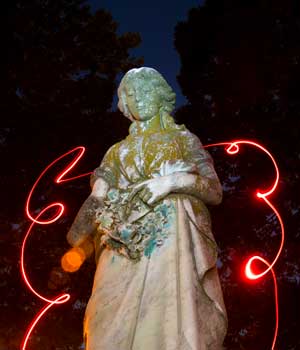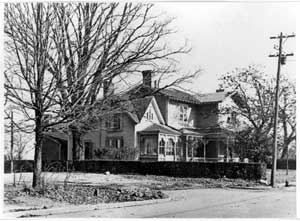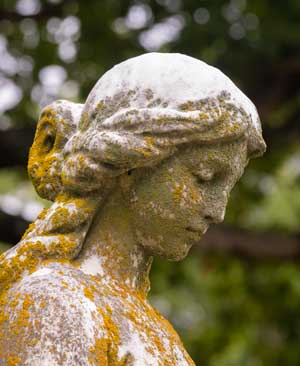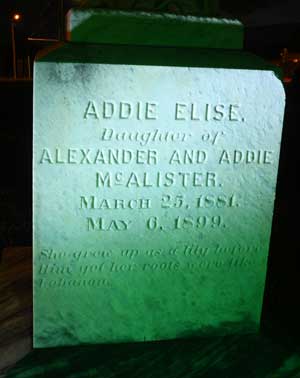Welcome!

This well-known local grave marker can be found in the Asheboro City Cemetery. (Eric Abernethy photo)
A tale that goes deep into Randolph County roots
Mary Murkin loves a good ghost story, and when the haunting has a historical tie to the neighborhood where her business is located, that’s even better.
She heard this snippet from the late, great Lane Ragsdale. He was a student at Asheboro High School at the time.
“The teenagers in the ’70s would go to the city cemetery on Friday night at midnight,” the proprietress of Brightside Gallery begins in the whispered tones best suited to a campfire tale.
“And by the light of the moon they could see Addie’s head turn to the left and turn to the right, and it was that she was looking for her hand. Everyone knows that’s important because the statue that stands there is missing one hand.”
The marble sculpture in question, commissioned in Italy more than a century ago, is above the grave of Elise “Addie” McAlister.
Who was Addie?
Born on March 25, 1881, to one of Asheboro’s premier families, Addie was by all accounts a gentle spirit, beloved by all who knew her. She was the youngest of Alexander Cary McAlister and Adelaide Worth McAlister’s eight children.
Her father, a former lieutenant colonel in the Confederate Army, hailed from a wealthy family in Cumberland County. Her mother was the daughter of prominent businessman Dr. John Milton Worth and the niece of Jonathan Worth, the only Randolph County resident to serve as governor of North Carolina (1865-1868). The couple made their home in Adelaide’s hometown.
The McAlisters’ splendid mansion stood at the intersection of Worth and Cox until it was torn down in the  1950s, to make room for the brand new Asheboro branch of the Randolph County Public Library. It’s right around the corner from Brightside Gallery, also on Worth.
1950s, to make room for the brand new Asheboro branch of the Randolph County Public Library. It’s right around the corner from Brightside Gallery, also on Worth.
Mary likes to call this part of her neighborhood the “mayors’ block.”
Among those were Henry “Hal” M. Worth, mayor from 1909-1911; Emory Kearns, Asheboro’s first undertaker and furniture maker and owner of the house that once occupied the site where Brightside is now, mayor from 1891-1895; and Joseph Dewese “J.D.” Ross Sr., who would dismantle Kearns’ dwelling in 1915 to build his bride, Ida, a new home (the current Brightside building), mayor from 1921-1923.
In this tight-knit neighborhood, young Addie must have felt cherished and secure, which makes what happened to her all the more heartbreaking.
At the age of 18, Addie fell ill of a mysterious ailment. She languished for six weeks, suffering and yet stoic. Despite the best efforts of doctors, she passed away on May 6, 1899.
Her obituary, published in The Charlotte Observer on May 9, 1899, delights Mary with its lovely prose and description of this gentle soul:
"Asheboro, May 8 — The funeral of Miss Elise McAlister took place in the Presbyterian church here yesterday morning at 11 o'clock. The services were conducted by Rev. Mr. Hodgin, of Westminister Presbyterian church, Greensboro; assisted by Rev. Mr. Plyler, of the Methodist church. The pall-bearers were Messrs. Claud Morris, Thomas Trogdon, Charles Rose, E.T. Moffitt, W. J. Armfield and Franklin Page.
"The Christian Endeavor Society, of which the deceased was an earnest member, attended the funeral as a group, carrying flowers, and a design made in their colors. The minister dwelt tenderly upon the words, “Precious in the sight of the Lord is the death of His saints;" giving the text as the only explanation of the death of one so fitted for and so willing to do His work on earth.
"The flower-laden casket was lowered into a flower-lined grave, and the grave itself covered and banked with exquisite flowers. Every word of the service, every note of the music, even the placing of the sod upon the coffin seemed a caress. So loved was she by old and young, for her purity of life and character.
"T he sickness of this child of God was an exceptional one. She was ill for a while. During the six long weeks of suffering and physical depression, and the severe treatment she endured in the fight for her life, she uttered no word of complaint or impatience. She expressed no anxiety about her condition, her countenance showing at all times perfect repose and comfort.
he sickness of this child of God was an exceptional one. She was ill for a while. During the six long weeks of suffering and physical depression, and the severe treatment she endured in the fight for her life, she uttered no word of complaint or impatience. She expressed no anxiety about her condition, her countenance showing at all times perfect repose and comfort.
"The physicians marveled at her composure, and look of calm always upon her face.
"It was on her face the day she was taken sick, an expression born of the repose of the soul, mind and heart.
" ‘The Master had come and was calling for her; He bore her sickness lovingly for her.’
For one so special, only a special commemoration would do.
Her father commissioned a marble statue to be carved in Italy and shipped to America, something that must have been extraordinary in those times since it warranted a mention in The Charlotte News.
“At Mr. I.W. Durham’s marble yard is to be a beautiful monument to be erected over Miss Elise McAlister’s grave at Asheboro. The figure which surmounts the pedestal represents memory — a girl with drooping head; a wreath of flowers in one hand and in the other a flower which she is in the act of dropping on the grave. The figure is of Italian marble. It was carved in Carrara, Italy, and is perfect in symmetry and work.”
Mary envisions the statue making the trip from Italy to a port in America, and then coming here by train, or perhaps horse and wagon, the only modes of transportation in the opening days of the 20th century. However it arrived in Asheboro, it arrived intact and was erected in the Asheboro City Cemetery with
the inscription:
SHE GREW UP AS A LILY BEFORE HIM, YET HER ROOTS WERE LIKE LEBANON.
How that beautiful work of art lost her hand is a mystery.
The tale of the hand
A customer in Mary’s shop provided the next chapter in Addie’s story. While browsing among the treasures and teas, the lady, who appeared to be in her 60s, shared her own ghostly brush with Addie.

Mary recalls her words:
“When she was a child playing in the graveyard, the hand was broken off the statue but still laying on the base of the monument. And one time she took that hand home. She was so fascinated with it.
“She described that very, very unlucky or bad or negative things started happening around their home.
“That scared her a lot so she told her mother she had brought that hand home from the cemetery and her mother declared that must have been what was bringing bad luck and negative things happening to their home and to their family, and she was to take that hand back to the cemetery and put it back to where it came from.
“So she did.”
The little girl placed the hand on the base of the monument and “that was the last of it.”
For her.
The hand mysteriously disappeared again.
Who took it and what fate befell them Mary has no idea.
A ghostly inspiration
“That began my fascination with Addie,” Mary admits and how the long-ago lass came to be part of the Asheboro Historic Downtown Ghost Walk, which just completed its sixth successful season.
On the walking tour, Addie makes an appearance, as do many other otherworldly denizens of Asheboro (through actors), including Mary’s own resident ghosts at Brightside — Emory, Ida and Evan.
Two of those have ties to Addie. Emory Kearns, as the undertaker of the time, would have laid Addie to rest. Ida, a contemporary of Addie’s, was the young wife who came to live in this house when J.D. Ross tore down Emory’s old house and built the current Brightside structure in 1917.
“We can tell when Emory is here with us because you can smell his pipe smoke,” Mary says.
“He was a known pipe smoker — that’s described in different articles, different photos of him. When he’s here with us, he’s usually standing in the jewelry room. That’s the only place you ever, ever, ever smell the pipe smoke.”
Mary speculates her specter isn't in the present-day jewelry room at all but rather in “his happiest place of all,” the apple orchard. Some mediums have heard the clunkety-clunkety-clunk of an apple cider press.
“I read an old article, late 1800s, that he had grown a 6-pound apple. You know that had to be the size of a basketball!” Mary laughs.
The freakish fruit was kept on display in the front office of the Randolph Regulator, the precursor of The Courier-Tribune, on Main Street, and folks would come from miles around to marvel at it.
In contrast to Emory’s residual presence, Ida is an active haunting, Mary says. Ida wanders from room to room, through the parlor and hallway, and up the stairs.
“We can tell when Ida is with us because you can smell the smell of her rose water cologne. Back in the Victorian days, rose water and lavender water were big scents going,” Mary says.
Ida also seems to prefer the color yellow, a gentle pale shade, which one investigator surmised may be honeysuckle — perhaps a favorite flower.
And then there’s Evan, a sprightly sprite who was known to move a wooden caterpillar when the toy room was upstairs and shuffle a box of photos so the picture of a young lad was in front.
The mediums who have “seen” him say he looks to be about 8 years old, dressed in old-timey Quaker clothing from the 1700s.
“Well, that makes sense since Randolph County was heavily settled by Quakers,” Mary agrees, noting the area around Brightside before the days of the Rosses and Kearns and McAlisters was farmland, and Evan could have died at a young age and been buried there.
One medium, who was interacting with Evan, had something else to share. It concerned the occupant of an upstairs office at Brightside.
“Evan likes that man who is in here,” the medium told Mary and echoed Evan’s words: “He looks like a dad” — the highest praise from a child.
Who was given such a spirited endorsement?
Why, none other than our own Ray Criscoe, editor of the Randolph Hub who has an office in the upstairs sunroom of Brightside.
When even ghosts find your presence comforting … well, you must be doing something right.
Annette Jordan is a writer with the Randolph Hub. Contact her at
ajordan5588@gmail.com.
